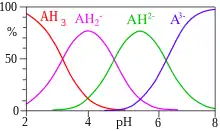 | |
 | |
| Names | |
|---|---|
| Preferred IUPAC name
Trisodium 2-hydroxypropane-1,2,3-tricarboxylate | |
| Other names
Sodium citrate Trisodium citrate Citrosodine Citric acid, trisodium salt E331 | |
| Identifiers | |
3D model (JSmol) |
|
| ChEMBL | |
| ChemSpider | |
| ECHA InfoCard | 100.000.614 |
| E number | E331iii (antioxidants, ...) |
PubChem CID |
|
| RTECS number |
|
| UNII |
|
CompTox Dashboard (EPA) |
|
| |
| |
| Properties | |
| Na3C6H5O7 | |
| Molar mass | 258.06 g/mol (anhydrous), 294.10 g/mol (dihydrate) |
| Appearance | White crystalline powder |
| Density | 1.7 g/cm3 |
| Melting point | > 300 °C (572 °F; 573 K) (hydrates lose water ca. 150 °C) |
| Boiling point | Decomposes |
| Anhydrous form:57 g/100 g H2O (25 °C) [1] Pentahydrate form: 92 g/100 g H2O (25 °C)[2] | |
| Hazards | |
| Occupational safety and health (OHS/OSH): | |
Main hazards |
Irritant |
| NFPA 704 (fire diamond) | |
| Lethal dose or concentration (LD, LC): | |
LD50 (median dose) |
1548 mg/kg (intraperitoneal, rat)[3] |
| Safety data sheet (SDS) | External MSDS |
| Related compounds | |
Related compounds |
Monosodium citrate Disodium citrate Calcium citrate Citric acid |
Except where otherwise noted, data are given for materials in their standard state (at 25 °C [77 °F], 100 kPa).
Infobox references | |
Trisodium citrate has the chemical formula of Na3C6H5O7. It is sometimes referred to simply as "sodium citrate", though sodium citrate can refer to any of the three sodium salts of citric acid. It possesses a saline, mildly tart flavor, and is a mild alkali.
Uses
Foods
Sodium citrate is chiefly used as a food additive, usually for flavor or as a preservative. Its E number is E331. Sodium citrate is employed as a flavoring agent in certain varieties of club soda. It is common as an ingredient in bratwurst, and is also used in commercial ready-to-drink beverages and drink mixes, contributing a tart flavor. It is found in gelatin mix, ice cream, yogurt, jams, sweets, milk powder, processed cheeses, carbonated beverages, and wine,[4] amongst others.
Sodium citrate can be used as an emulsifying stabilizer when making cheese. It allows the cheese to melt without becoming greasy by stopping the fats from separating.
Buffering

As a conjugate base of a weak acid, citrate can perform as a buffering agent or acidity regulator, resisting changes in pH. It is used to control acidity in some substances, such as gelatin desserts. It can be found in the milk minicontainers used with coffee machines. The compound is the product of antacids, such as Alka-Seltzer, when they are dissolved in water. The pH of a solution of 5 g/100 ml water at 25 °C is 7.5 – 9.0. It is added to many commercially packaged dairy products to control the pH impact of the gastrointestinal system of humans, mainly in processed products such as cheese and yogurt, although it also has beneficial effects on the physical gel microstructure.[5]
Chemistry
Sodium citrate is a component in Benedict's qualitative solution, often used in organic analysis to detect the presence of reducing sugars such as glucose.
Medicine
In 1914, the Belgian doctor Albert Hustin and the Argentine physician and researcher Luis Agote successfully used sodium citrate as an anticoagulant in blood transfusions, with Richard Lewisohn determining its correct concentration in 1915. It continues to be used today in blood-collection tubes and for the preservation of blood in blood banks. The citrate ion chelates calcium ions in the blood by forming calcium citrate complexes, disrupting the blood clotting mechanism. Recently, trisodium citrate has also been used as a locking agent in vascath and haemodialysis lines instead of heparin due to its lower risk of systemic anticoagulation.[6]
In 2003, Ööpik et al. showed the use of sodium citrate (0.5 g/kg body weight) improved running performance over 5 km by 30 seconds.[7]
Sodium citrate is used to relieve discomfort in urinary-tract infections, such as cystitis, to reduce the acidosis seen in distal renal tubular acidosis, and can also be used as an osmotic laxative. It is a major component of the WHO oral rehydration solution.
It is used as an antacid, especially prior to anaesthesia, for caesarian section procedures to reduce the risks associated with the aspiration of gastric contents.
Boiler descaling
Sodium citrate is a particularly effective agent for removal of carbonate scale from boilers without removing them from operation[8] and for cleaning automobile radiators.[9]
See also
References
- ↑ "Sodium citrate | 68-04-2". Retrieved 14 December 2023.
- ↑ "CRC Handbook of Chemistry and Physics". Retrieved 22 November 2013.
- ↑ Chambers, Michael. "ChemIDplus - 68-04-2 - HRXKRNGNAMMEHJ-UHFFFAOYSA-K - Sodium citrate anhydrous - Similar structures search, synonyms, formulas, resource links, and other chemical information". chem.nlm.nih.gov.
- ↑ "Permitted Emulsifying Salt (E331)".
- ↑ Ozcan-Yilsay, T; Lee, W.-J. (2007). "Effect of Trisodium Citrate on Rheological and Physical Properties and Microstructure of Yogurt". Journal of Dairy Science. 90 (4): 1644–1652. doi:10.3168/jds.2006-538. PMID 17369204.
- ↑ "Locking Solutions for Hemodialysis Catheters" (PDF).
- ↑ V. Ööpik; I. Saaremets; L. Medijainen; K. Karelson; T. Janson; S. Timpmann (2003). "Effects of sodium citrate ingestion before exercise on endurance performance in well trained college runners". British Journal of Sports Medicine. 37 (6): 485–489. doi:10.1136/bjsm.37.6.485. PMC 1724692. PMID 14665584.
- ↑ U.S. Patent 3,095,862
- ↑ "MSDS" (PDF).
